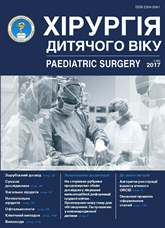A case of small bowel obstruction of a rare etiology in a newborn with gastroschisis
DOI:
https://doi.org/10.15574/PS.2017.55.27Keywords:
gastroschisis, omphalomesenteric vessel, compression of small intestine, surgical treatment, infantAbstract
Gastroschisis (GS) in a fetus was diagnosed by prenatal ultrasonography (US) at a period of 28 weeks of gestation. Prenatal US follow-up monitoring and examinations were conducted. The delivery was performed by a planned preterm cesarean section at 36-37 weeks of gestation. Surgical treatment of GS was performed in 15 minutes after birth, according to the tactics «Surgery of the first minutes», developed in our clinic. During the primary operative intervention, unobliterated omphalomesenteric vessel caused a small bowel obstruction (SBO) was discovered and removed. On 14th day after the primary operation, the child was reoperated because of the partial intestinal obstruction symptoms. During the reoperation, the functional obstruction of the small intestine in the site of a previously removed omphalomesenteric vessel was revealed. A resection of 10.0 cm of the ileum with a narrowing segment was performed and an anastomosis end-to-end was created. Recurrence of the intestinal obstruction after the surgery was not observed, complete enteral nutrition was achieved. The effect of the performed step operations is good.
Conclusions. Proposed surgical tactics and strategy of complicated GS associated with partial SBO was effective and can be used in cases of ileum obstruction caused by an aberrant omphalomesenteric vessel.
References
Sliepov OK. (2013). Sposib plastyky pupkovoho kiltsia pry hastroshyzysi u novonarodzhenykh. Pat. 77788 Ukraina, MPK A61B 17/00. Zaiavnyk ta vlasnyk patentu DU «IPAH NAMN Ukrainy». No.201210316; zaiavl 31.08.2012; opubl 25.02.2013. Biul No.4.
Sliepov OK, Hrasiukova NI, Veselskyi VL. (2014). Rezultaty «khirurhii pershykh khvylyn» pry likuvanni hastroshyzysu. Perinatology and pediatric. Ukraine. 4: 18–23.
Jalil O, Radwan R, Rasheed A et al. (2012). Congenital band of the vitelline artery remnant as a cause of chronic lower abdominal pain in an adult: Case report. Int J Surg Case Rep. 3(6): 207–208. https://doi.org/10.1016/j.ijscr.2012.01.011; PMid:22466111 PMCid:PMC3324705
Prust FW, Abouatme J. (1969). Vitelline artery causing small bowel obstruction in an adult. Surgery. 65; Is 4: 716–720.
Mastroiacovo P, Lisi A, Castilla EE et al. (2007, Apr 1). Gastroschisis and associated defects: an international study. Am J Med Genet A. 143A(7): 660–71. https://doi.org/10.1002/ajmg.a.31607; PMid:17357116
Kronfli R, Bradnock TJ, Sabharwa A. (2010). Intestinal atresia in association with gastroschisis: a 26-year review. Pediatr Surg Int. 26: 891–894. https://doi.org/10.1007/s00383-010-2676-4; PMid:20676892
Benirschke K, Kaufmann P. (1990). Pathology of the Human Placenta: Second edition. New York: Springer Science & Business Media: 180–192. https://doi.org/10.1007/978-1-4757-4193-3
Moore TC. (1996). Omphalomesenteric duct malformations. Semin Pediatr Surg. 5(2): 116–23. PMid:9138710
Hansraj N, Larabee SM, Lumpkins KM. (2016). Anomalous mesenteric vessel – a rare etiology of intermittent partial small bowel obstruction. Journal of Surgical Case Reports. 12: 1–3. https://doi.org/10.1093/jscr/rjw209
Stoll C, Alembik Y, Dott B, Roth MP. (2008). Omphalocele and gastroschisis and associated malformations. Am J Med Genet A. 15;146A(10): 1280–5.
Lao OB, Larison C, Garrison MM et al. (2010). Outcomes in neonates with gastroschisis in US children’s hospitals. Am J Perinatol. 27: 97–101. https://doi.org/10.1055/s-0029-1241729; PMid:19866404 PMCid:PMC2854024
Hollabaugh RS, Boles Jr. ET. (1973). The management of gastroschisis. J of Ped Surg. 8; Is 2: 263–270.
Driver CP, Bruce J, Bianchi A et al. (2000). The contemporary outcome of gastroschisis. J Pediatr Surg. 35: 1719–1723. https://doi.org/10.1053/jpsu.2000.19221; PMid:11101722
Aikaterini T Michopoulou, Stylianos S Germanos, Anestis P Ninos et al. (2013). Vitelline artery remnant causing intestinal obstruction in an adult. Surgery. 154; Is 5: 1137–1138.
Downloads
Issue
Section
License
The policy of the Journal “PAEDIATRIC SURGERY. UKRAINE” is compatible with the vast majority of funders' of open access and self-archiving policies. The journal provides immediate open access route being convinced that everyone – not only scientists - can benefit from research results, and publishes articles exclusively under open access distribution, with a Creative Commons Attribution-Noncommercial 4.0 international license(СС BY-NC).
Authors transfer the copyright to the Journal “PAEDIATRIC SURGERY.UKRAINE” when the manuscript is accepted for publication. Authors declare that this manuscript has not been published nor is under simultaneous consideration for publication elsewhere. After publication, the articles become freely available on-line to the public.
Readers have the right to use, distribute, and reproduce articles in any medium, provided the articles and the journal are properly cited.
The use of published materials for commercial purposes is strongly prohibited.

